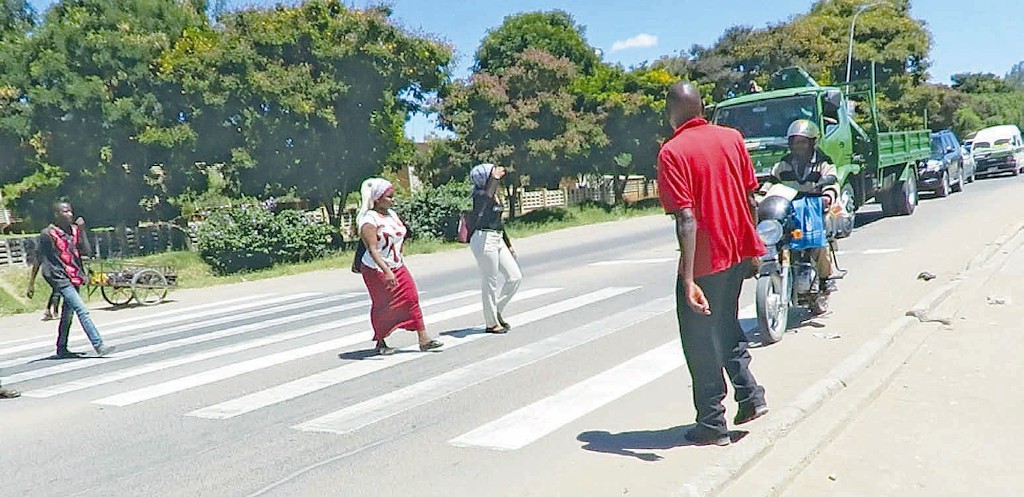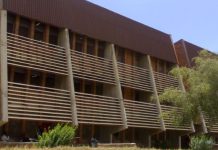ONCE bitten, twice shy as Samuel Daudi stands near the pedestrian crossing line, pondering along the Dodoma- Morogoro highway in the Capital City on his next move.
Firmly holding his crutches, the uneasy and visibly nervous 57-year old man takes courage at the presence of a traffic police officer helping pedestrians to cross the busy road.
Despite the Police Officer motioning him and others to cross, he carefully checks both sides of the road before swiftly sets himself in motion, crossing the black spot, which the police described as the region’s busiest zebra crossing.
Pedestrians, most notably students in groups have to brave careless driving and speeding vehicles to perform a risky task of crossing the road every day. It is one of the most utilized crosswalks in Dodoma.
“I have become extra cautious whenever I cross this road,” says Mr Daudi, revealing that a few years ago, he cheated death by a whisker when he was knocked down by a vehicle while crossing this same road, some few kilometers from here.
“I was hit by a vehicle at Ipagala area while crossing the road on my way back home … luckily I survived but lost my leg. I suffered multiple fractures on my left leg and was eventually amputated,” he added.
Pitifully, it was a hit-andrun incident as the driver disappeared into thin air after hitting and leaving Daudi for dead.
“I never thought it could happen to me. It was really a horrible and difficult experience, but I had to accept the fact that I was meant to live my life on crutches,” he recalls his ordeal.
“The zebra crossing is supposed to be an aid for pedestrians, especially when we cross a busy road like this one. Unfortunately, there is zero adherence to the demands of the crossing point by motorists, who speed past despite the presence of pedestrians,” says Daudi.
Robert James, a secondyear student at CBE, reinforces Daudi’s assertion saying that many students find this road scary to navigate.
“It is difficult to cross the road despite the pedestrian crossing; most of the time motorists don’t slow down even when they see groups of pedestrians standing at the zebra ready to cross,” laments Robert.
The nightmare faced by pedestrians at this Dodoma zebra crossing is just but a tip of an iceberg, as it depicts the predicament of pedestrians in the country.
Reckless drivers, poor and unfriendly road infrastructure provide a nightmare to pedestrians whose lives are at risk every time they move from one point to another.
In most cities, pedestrians are forced to maneuver their way around vehicles that fail to slow down even at crossing points. This has seen many intersections and crossing points turning into death traps for pedestrians.
“Crossing the roads has become really scary, especially when there is heavy traffic as people are regularly hit by speeding vehicles; unfortunately, the culprits escape the arm of the law,” says Daniel Saningo, who lost his sibling three years ago, in a hit-and-run incident.
Statistics from the Police Traffic Department show that 71 pedestrians lost their lives between January and March this year in road accidents, while 467 pedestrians died last year and 751 in 2017.
During the past five years (2014-2018) 4,274 pedestrians were among the 14,853 killed due to road crashes across the country. That is unacceptably high as it constitutes 29 percent of all road fatalities during this period.
A further 7,431 pedestrians suffered non-fatal injuries between 2014 and 2018 – of which some of them were left with permanent disabilities.
The statistics paint a gloomy picture on the plight of pedestrians, cyclists and other vulnerable road users and add wait to an outcry by road safety stakeholders to scale up evidence-based interventions and investment.
Lack of proper footpaths, users-responsive zebra-crossings and a lack of awareness about road etiquette have made Tanzanian cities hazardous places to walk on, according to road safety experts and users ‘own accounts.
The World Health Organization (WHO) has identified driver behaviour particularly in terms of speeding and drinking and driving, and infrastructure in terms of a lack of dedicated facilities for pedestrians such as sidewalks, raised crosswalks and medians as among the key risks to pedestrians.
Coordinator for Violence and Injury Prevention – Road Safety, health systems cluster for WHO, Ms Mary Kessi, lists the other causes as inadequate visibility of pedestrians, unsafe driving practices, driver distraction, including mobile phone use, driver fatigue; pedestrian–vehicle conflict at pedestrian crossing points and reduced reaction time and reduced walking speed for the elderly.
Inability of children to gauge vehicle speed and other relevant information in order to cross the street safely alone, as well as lack of supervision of children who are too young to make safe judgments, also contribute massively to pedestrian deaths, says Ms Kessi.
“Pedestrian distraction, especially mobile phone use is another emerging cause for pedestrian deaths,” she adds, noting that poor trauma care services on the other hand thwart efforts to provide the urgent treatment needed to save pedestrians’ lives.
Assistant Superintendent of Police (ASP) Deus Sokoni says that pedestrian accidents quite often are a result of complex circumstances and the reaction of a number of factors related to driver and pedestrian behaviour and road infrastructure.
ASP Sokoni admits that reckless driving on the country’s roads is one of the prime causes of road fatalities among pedestrians and other vulnerable road users.
But equally, the pedestrians must take responsibility for their lives. Unfortunately, many people do not exercise precaution when crossing highways, ASP Sokoni says.
“It is not always the case that motorists are at fault, sometimes you find that a pedestrian was responsible for an accident,” says ASP Sokoni.
“And, in fact, the law states that a pedestrian wishing to cross a carriageway shall, where there is a pedestrian crossing, exercise due care and use that pedestrian crossing to cross the carriageway,” adds Sokoni.
He argues that roadway is a shared space and all road users— whether motorists, pedestrians or cyclists — have a part to play in ensuring their safety and the safety of others using the road.






